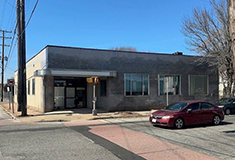News:
Rhode Island
Posted: March 11, 2009
Stimulus for R.I. school construction depends on state & local gov't. action
Rhode Island cities and towns have put many planned new construction and renovation projects on hold due to the current economic climate. Among them are several public school projects in places such as Newport and North Kingstown.
"We urge all R.I. cities and towns to reconsider any deferred renovation and repair projects and to expedite their plans for any others nearly ready for construction to avoid losing any chance of applying stimulus package funds to critical projects," said Eric Anderson, executive director of the Rhode Island Associated General Contractors (RIAGC). "In addition to providing greatly needed repairs to our schools, such spending would help lessen the impact of decreased spending and unemployment in Rhode Island's nonresidential building construction industry."
Unlike the federal grants made available for state application specifically for transportation infrastructure, the final version of the American Recovery and Reinvestment Act of 2009 did not include funds dedicated solely to school construction and renovation. Instead, the stimulus bill included school modernization funds within the $53.6 billion of State Fiscal Stabilization Funds to be distributed by the U.S. Department of Education. This leaves the budget for school modernization (new construction was eliminated) up to state and local governments.
The U.S. Department of Education's preliminary estimate (as of Feb. 17) of Rhode Island's share of the $53.6 billion is nearly $165 million. Funds for Title I, Title II and other educational purposes are included in grants that are not part of the State Fiscal Stabilization Fund.
A Feb. 12 news release of the House Appropriations Committee estimated that the $53.6 billion included school building infrastructure within $39.5 billion to go to "local school districts using existing funding formulas, which can be used for preventing cutbacks, preventing layoffs, school modernization, or other purposes." Additionally, it included $8.8 billion available to states "for high priority needs such as public safety and other critical services, which may include education and for modernization, renovation and repairs of public school facilities and institutions of higher education facilities."
"It is incumbent upon our state and local officials to make sure that we address the most critical school building needs as soon as possible to avoid losing any of this federal assistance to other states," Anderson said.
"Nonresidential building contractors have seen a very steep drop in government and commercial construction projects in the last several months," he added. "Consequently, they have the immediate capacity to handle any expedited school modernization projects and more."
In addition to the unspecified amounts within the State Fiscal Stabilization Fund for school modernization, the stimulus bill provided $29.5 billion nationally (reduced from the previous $54.9 billion House and $58.6 billion Senate proposals) for federal building infrastructure projects. Most of this would be distributed on a discretionary basis rather than competitively awarded. "We don't yet know how much, if any of the work would involve R.I. facilities," Anderson said.
R.I. Construction Employment
Economists at the Associated General Contractors of America's headquarters are tracking national and state-specific stimulus bill information related to construction as well as construction employment figures on a frequently updated web page at www.agc.org/stimulus. Rhode Island's construction employment (residential and nonresidential) has decreased 17.9 percent from its peak of 23,400 workers in January 2007 to 19,200 in December 2008. Each additional $1 billion in nonresidential construction spending would add about $2 billion to Rhode Island's gross domestic product, increase personal earnings by about $584 million and create or sustain 16,000 jobs, according to Ken Simonson, AGC of America's chief economist.
About 5,400 of these jobs would be on-site construction jobs located within Rhode Island. Some 2,600 would be direct and indirect jobs associated with construction supply materials and services with the majority located within the state. The remaining 8,000 would be created when construction, supplier and service providers spend their incomes, and would be based both in Rhode Island and throughout the economy.
Tags:
Rhode Island
MORE FROM Rhode Island
Washington Trust named one of healthiest employers in Rhode Island by PBN
Westerly, RI For the fourth year in a row, Washington Trust has been named by Providence Business News (PBN) as one of the healthiest employers in Rhode Island. Washington Trust was one of 27 organizations selected for PBN’s 2025 Healthiest Employers Awards,

Columns and Thought Leadership

Diverse mix of businesses makes Warwick the perfect community - by Frank Picozzi
For those looking for some recreation in the great outdoors, wooded trails and biking paths with spectacular water views, lush green grass perfect for a picnic, fun playgrounds with all the amenities, and modern sports fields can be found easily throughout Warwick. But what does one do when the

The City of Warwick is the perfect choice - by Frank Picozzi
The late summer sky was bright and the mood festive at the family-friendly “Best in Town” event at Rhode Island’s first Floor & Décor store. Those looking to make some home improvements strolled through the warehouse, admiring the well-stocked aisles, fair

Nine Post Rd. receives approval for six units and commercial space - by Frank Picozzi
After several years of planning, the owners of a property in historic Pawtuxet Village recently received planning board master plan approval for a mixed-use building consisting of six residential units and 1,510 s/f of commercial space along the banks of the majestic Pawtuxet River.

Warwick offers convenience of city living, but feels like a smaller, close-knit community - by Frank Picozzi
Located in the heart of southern New England, Warwick is a perfect community in which to locate your business, or find a spot to develop commercial and residential projects. Warwick brings the convergence of air, rail, highway, and maritime travel in one convenient, central location. We’re home to Rhode Island T.F. Green







.png)


.png)